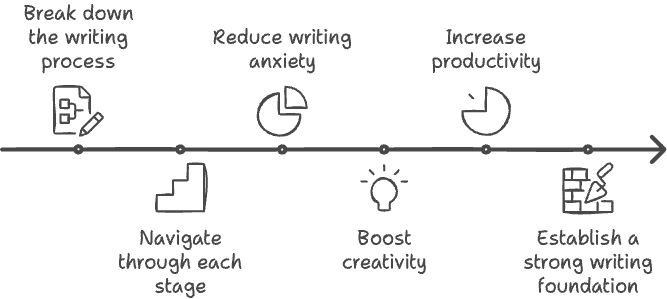One small step...

Simplified Step-by-Step Guide to Getting Started Writing
Step 1: Choose Your Comfort Zone
- Action: Pick a topic you know well or enjoy.
- Benefit: This reduces anxiety and boosts confidence in your writing.
- Example: "My favorite weekend activity: Hiking"
Step 2: Focus on a Single Aspect
- Action: Narrow down to one specific element of your topic.
- Benefit: This prevents overwhelming yourself and keeps your writing focused.
- Example: "Why hiking boosts my mood"
Step 3: Craft Your Opening Line
- Action: Write a simple, engaging first sentence that introduces your main idea.
- Benefit: This sets the tone and draws readers in immediately.
- Example: "Every step I take on a hiking trail feels like a step away from stress and towards happiness."
Step 4: Brain Dump
- Action: Spend 5 minutes writing down every thought related to your topic without judgment.
- Benefit: This frees your mind and provides raw material for your writing.
- Example: "Fresh air, exercise, nature, trees, birds, quiet, peaceful, challenging, views, accomplishment, friends, picnics, photos, sore muscles, water bottles, hiking boots, backpack, trail mix..."
Step 5: Organize Your Thoughts
- Action: Group similar ideas from your brain dump into 3-4 main points.
- Benefit: This creates a simple structure for your writing, making it easier to develop your ideas.
- Example:
- Connection with nature
- Physical challenge and health benefits
- Sense of accomplishment and peace
Step 6: Expand Each Point
- Action: Write 2-3 sentences for each main point, focusing on clarity over perfection.
- Benefit: This builds the body of your writing in manageable chunks, making the task less daunting.
- Example: "Hiking connects me with nature in a unique way. The sound of leaves crunching under my feet and birds chirping overhead makes me feel part of something bigger than myself. It's a reminder of the beauty that exists beyond my daily routine."
Step 7: Connect Your Ideas
- Action: Add a sentence between each main point to create smooth transitions.
- Benefit: This improves the flow of your writing and makes it easier for readers to follow your thoughts.
- Example: "While the connection with nature is rejuvenating, the physical aspect of hiking adds another layer to its mood-boosting effects."
Step 8: Wrap It Up
- Action: Write a concluding sentence that echoes your opening and summarizes your main points.
- Benefit: This gives your writing a sense of completion and reinforces your message.
- Example: "From the peace I find in nature to the pride I feel after conquering a tough trail, hiking truly is my go-to mood booster and favorite weekend escape."
Step 9: Take a Break
- Action: Step away from your writing for at least 30 minutes.
- Benefit: This allows you to return with fresh eyes, making it easier to spot areas for improvement.
Step 10: Read and Revise
- Action: Read your writing aloud, marking any parts that sound awkward or unclear.
- Benefit: This helps you identify areas that need improvement and ensures your writing sounds natural.
- Example: After reading aloud, you might change "It's a reminder of the beauty that exists beyond my daily routine" to "It reminds me that there's a whole world of beauty beyond my daily grind."
Step 11: Seek Constructive Feedback
- Action: Share your writing with a trusted friend or use an online writing community.
- Benefit: This provides valuable outside perspective and encouragement.
- Example: A friend might suggest adding a specific example: "Maybe mention your favorite local hiking spot to make it more personal?"
Step 12: Reflect and Set Goals
- Action: After each writing session, note what went well and one thing you'd like to improve next time.
- Benefit: This creates a personal growth plan and builds confidence over time.
- Example: "I'm happy with how I described the connection to nature. Next time, I want to work on using more varied sentence structures."
Remember: Each time you write, you're taking steps on your own writing journey. Just like hiking, it gets easier and more enjoyable with practice!
